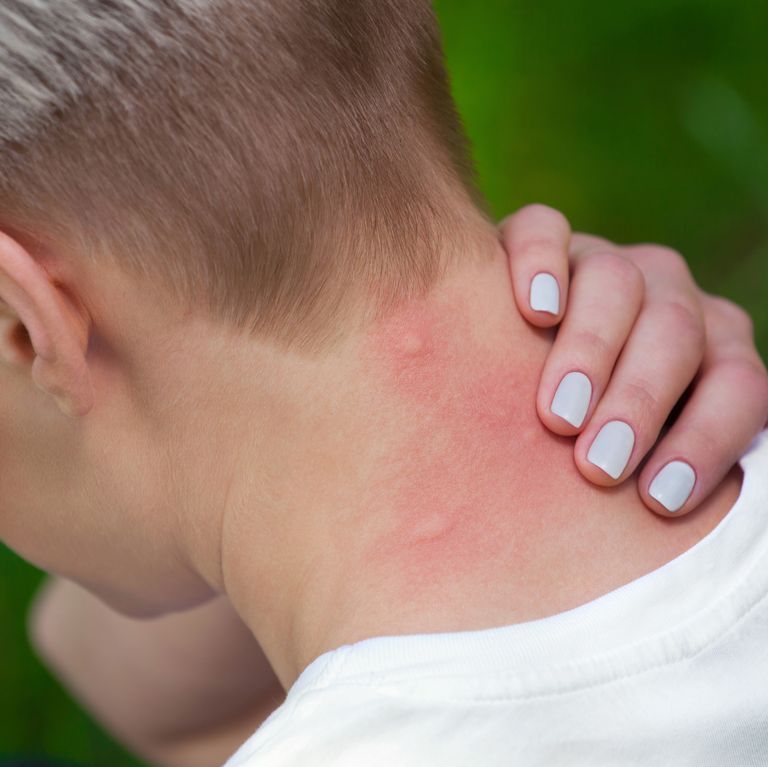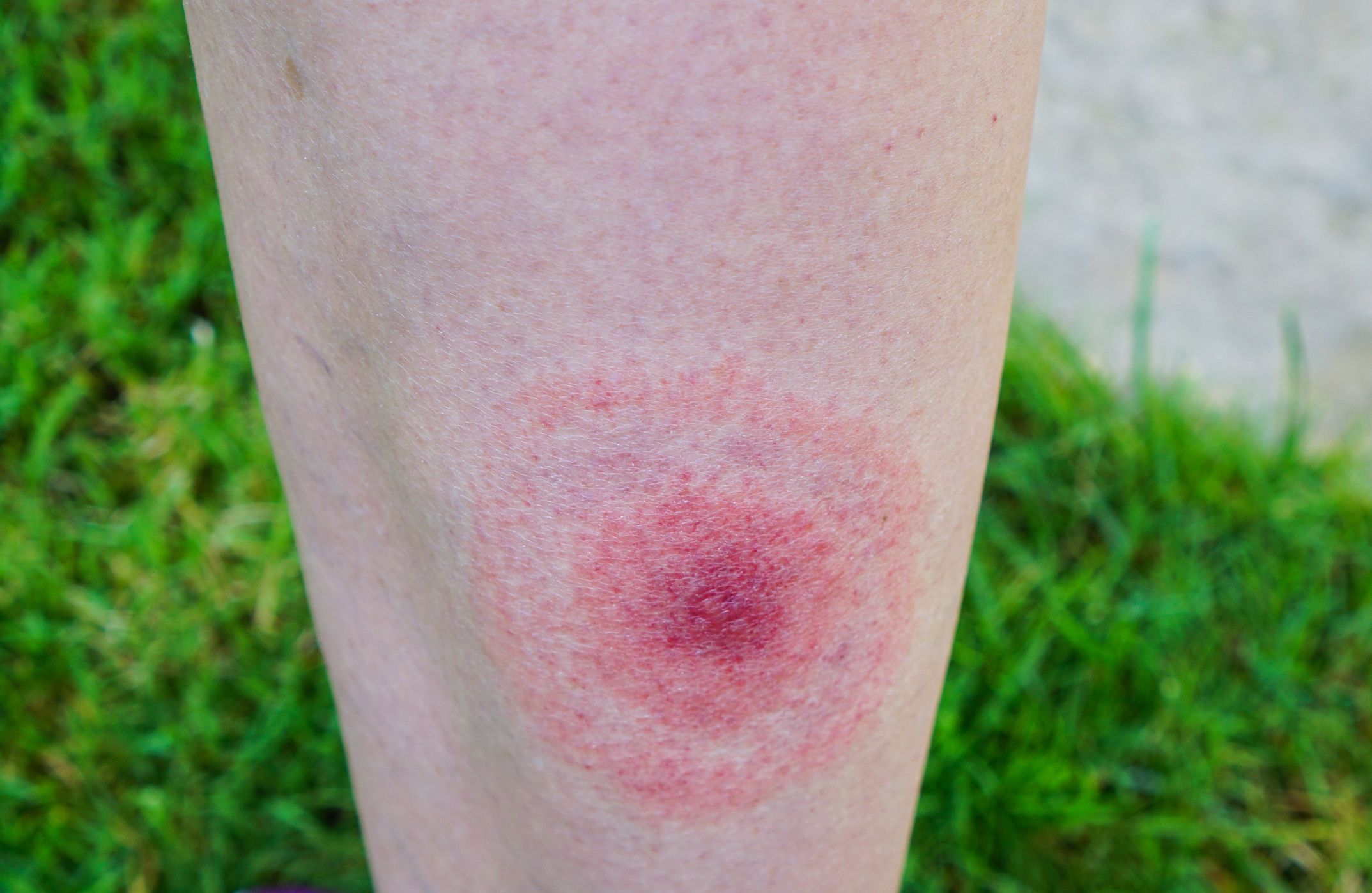You Should Never Brush Off A Tick Bite If It Looks Like THIS

If you played outside a lot growing up or are an avid hiker, you’ve probably heard time and time again that you should *always* do a tick check when you come inside. But given that ticks are teeny-tiny and easy to overlook on your body, you might not always catch one or even realize a tick bit you until it’s too late and symptoms start to hit you.
Nearly 60,000 tick-borne illnesses were reported in 2017 in the United States, following a trend of steadily increasing cases each year, according to the Centers for Disease Control and Prevention (CDC). And a rise in tick-borne illnesses—two of the best-known in humans are Lyme disease or Rocky Mountain Spotted Fever—isn’t something to take lightly, as these conditions can make you feel pretty sick. If left untreated, they can cause a host of serious, long-term symptoms, ranging from arthritis to cardiovascular and neurological problems.
Don’t worry: Finding a tick on your body after a weekend camping trip is not a guarantee that you’ll be plagued with illness, according to Walter Schrading, MD, director of the Office of Wilderness Medicine at the University of Alabama at Birmingham. “The tick bite itself is not dangerous and doesn’t cause any symptoms or rash unless it’s carrying one of the major diseases we worry about,” Dr. Schrading explains. “Otherwise, the tick can just be removed with tweezers, [with nothing but] local irritation around the bite.”

Hopefully you already know that prevention (i.e. wearing long sleeves and pants outside and loading up on insect repellents that contain DEET or permethrin) is the best way to avoid contracting a tick-borne illness this summer. But if it’s too late for prevention, here are six photos to help you figure out whether that bite could be from a tick, plus what to expect next if it is.
What does a tick bite typically look like?
https://www.instagram.com/p/Bw6rlNGBurl/
#ticks #tick #tickbite Well, the season has started. I found 3 walking on Lola the other day, and last night I woke up with a tick pinched between my fingers in the process of removing it. I move in my sleep…part of my neurological problem. It was a clean removal, luckily, and I cleaned the spot and went back to bed. It was not attached for long because it was still hard and flat.A tip for ticks: once you remove them, enfold them into clear tape. It keeps the tick visible on both sides so a doctor can determine the tick type. You also can write a date on the tape to know which tick bit you on what date if labs want to test the tick. I have begun the habit of doing this so that there is no arguing with me in the walk-in if I feel sick some days later and speculate I have contracted something from the bite. I also get a clear picture of the bite area. This is not a clear picture, I took several. I use a mirror to see the screen while using the camera on the back of my phone, which has zoom and auto adjust for clarity.I hope it is not like this all summer. Ticks are a parasite I do not like. 😨🤢
A post shared byKate DeNyse (@katedenyse) on
The tick bite itself will likely be so small and painless (just a little red dot, if anything) that you won’t actually notice it, says Qurat Mudassar, MD, an infectious disease specialist and primary care physician at Norwalk Hospital in Connecticut. You’ll likely only become aware that one of those little buggers has latched onto you if you actually find the tick attached to your skin, or if you develop one of the tell-tale rashes (or other symptoms) that signals you’ve been infected with a tick-borne illness.
The hallmark sign of Lyme infection is a rash that resembles a bullseye. “[With Lyme disease], the rash is a localized infection,” Dr. Mudassar says. “The center may be clear with a red, circular margin outside.” This rash may also become itchy or swollen for some people.
https://www.instagram.com/p/Bm1a0RUhfTd/
Do you know the symptoms of Lyme Disease? They may include a circular, red “bull’s eye” rash, fatigue, fever or chills, headache, joint pain, muscle aches and more. Visit durham.ca/lyme #targetlyme #lymedisease #bullseyerash #ticks #hiking #trails #DurhamRegion #biking
A post shared byDurham Region Health (@durhamregionhealth) on
Here’s where it gets a little more complicated: Not everyone who develops Lyme disease gets a rash, and even the people that do often don’t notice it, Dr. Mudassar says. Plus, the rash can show up on other areas of the body away from the bite site, so it might not raise any red flags.
A Rocky Mountain Spotted Fever rash, on the other hand, is more obvious. This bacterial infection causes a rash on the extremities of the body (think: your palms, ankles, and soles of your feet), which migrates toward the center of your body, per Dr. Schrading.
https://www.instagram.com/p/Bja9PnkAqPH/
Y’all, CHECK YOUR BABIES AND YOURSELVES FOR TICKS! This is #Rockymountainspottedfever from a tick 😬😬 Lou Ann spent 3 hours in urgent care, 5 hours in Winchester ER, and she is now is St. Thomas Hospital in Murfreesboro! This is a woman who doesn’t spend a whole lot of time outdoors, in high grass, or in the woods. Without treatment it can be fatal! Thankfully My mom has a few daughters who wouldn’t rest til she got help! She should get to come home tomorrow ❤️
A post shared byAlanna Taylor (@alannnaaataylor) on
What if I don’t get a rash but still feel super sick?
Since you can’t always rely on a rash to clue you in, pay attention to other signs of illness you experience after possible exposure.
Dr. Mudassar says that tick-borne illnesses can cause fever, fatigue, loss of appetite, headache, muscle pain, and regional lymph node swelling in the early stages of the disease.
Dr. Schrading adds that you might simply have nonspecific viral illness symptoms, like malaise and myalgia—so it helps to consider the time of year you’re feeling sick. “More people are outside and around ticks in the summer, which isn’t flu season,” he says. “So if you’re feeling like you have the flu in the middle of summer, think about whether you could have been exposed to a tick.”
Does it matter what kind of tick bit me?
https://www.instagram.com/p/BvuAwCjHWXR/
Brought back a friend from #rockygapstatepark this weekend. @joyceannsun found it on me this morning. Sure glad she did. Tried tweezers but we think the head is still on, so between that and the redness, it’s of to the #dermatologistthis afternoon. Just want to make sure things are ok. Sorry for the gross picture, but I just wanted to remind everyone to watch out for #ticks, yes they are out and about this early here in #Maryland. I think it’s a larger #tick and not a smaller deer tick, which carry #lymedisease. The larger one around here can carry #rockymountainspottedfever though, plus I’m certainly not an expert do I want to get it checked out.
A post shared byDenman (@lefauxpas) on
There are many different species of ticks, but the detail that matters is whether you were bitten by a deer tick (a.k.a. a blacklegged tick) or dog tick, which are known to transmit these two major diseases to humans.
“The only two major diseases we see reside in deer and dog ticks—if you’re bitten by a random tick that doesn’t transmit disease, you’ll be fine,” says Dr. Schrading, who clarifies that deer ticks transmit Lyme disease and dog ticks transmit Rocky Mountain Spotted Fever.
Other ticks, like the Lone Star tick, for example, also transmit diseases. But infections from Lone Star ticks make up a small percentage of all tick-borne illnesses, per the CDC.
https://www.instagram.com/p/BjGDfumnlys/
Just pulled this little critter off of me last night. This is an adult female Amblyomma americanum, also known as the Lonestar tick. Ironically, I never saw these when I lived in the Lonestar state 😝These ticks can easily be identified by the white “star” on the back of the tick and are usually much larger than the traditional deer tick. They are usually found in wooded areas (my wooded backyard explains it all!). This tick does not transmit Lyme, but is involved in the Alpha-gal allergy phenomenon (meat allergy). This is a very unlikely, but is thought to occur from the tick bite triggering an immune response to a carbohydrate found in mammalian meat (red meat). Tick season is upon us! Make sure to check your skin after any time spent outside 👍 #ticks #tickseason #lonestar #lonestartick #insect #outdoors #dermatology #boardcertifieddermatologist #skincare #easternshore #easternshoremd #oceancitymaryland #berlinmd #selbyville #fenwickisland
A post shared bySara Moghaddam, MD, FAAD (@drsaramd) on
The tricky thing is that there’s no way to tell from the actual bite itself which tick nabbed you. That said, if you develop the classic bullseye rash or a spotted rash spreading across your body, it’s pretty clear which tick was the culprit. At that point, you should definitely hightail it to your doctor’s office for evaluation, which Dr. Mudassar says is worth doing for *any* tick bite, even one that isn’t causing symptoms yet.

“It’s better if you go to the doctor right away when you know you’ve had a tick bite,” says Dr. Mudassar. “If you go within 36 hours of the bite, you can be treated with a lesser dose of antibiotics [if your doctor determines that’s necessary].”
Your doctor may be able to test you for illness with blood work to identify the pathogen. But Dr. Schrading warns it can take a while for results to come back, and false negatives can occur.
If I did get a tick-borne illness, how long does it take for symptoms to appear?
A tick will spend the first 12 to 24 hours on your body looking for a place to settle in, Dr. Mudassar says. Once it finds a desirable spot—like your armpit, groin, or the back of your neck—it will latch on.
From there, it takes a few days for the tick to actually transmit any illness it might be carrying; Dr. Schrading notes that it could be about four to seven days before a rash or symptoms appear.
https://www.instagram.com/p/Bj2wwOwFqgR/
🚨Tick bite🚨 I’ve had a terrible week to say the least. I went from 💯 to zero within a day. Not only did a nasty little bug get me sick but so did the medicine to cure it. 🕷💊 Just to create some awareness #lymedisease is real and can happen to anyone. Take precautions and learn about how to respond to a #tickbite. This was my arm over a three day period. #lymediseaseawareness #lymerash #bullseyerash #deertick #braxtoncounty #tickssuck #fitnessproblems
A post shared byWhere’s Your Will To Be Weird? (@krileyzin) on
What if the tick that bit me didn’t transmit an infection?
If you know for sure a tick bit you because you found it attached to your skin, it’s still totally possible you won’t contract an illness. Why? Well, not all ticks carry diseases, for starters. But there’s also a correlation between the length of time the tick was attached to you and how likely you are to get sick.
“Removing the tick as soon as possible reduces risk of infection if it’s carrying a disease,” says Dr. Schrading. “The less time it’s attached to you, the less likely it is to infect you, especially if it’s been less than 12 hours.”
Remember: Your best bet for avoiding tick-borne illnesses is prevention, and then early detection. Do careful tick checks after you’ve spent time outside and don’t wait around for symptoms to start if you think a tick bit you. You can also keep tabs on local tick activity in your area by contacting your state’s health department (or visiting their web site).
Source: Read Full Article




